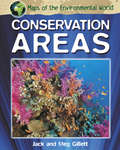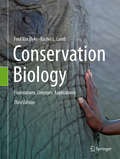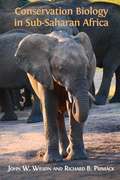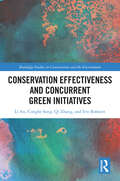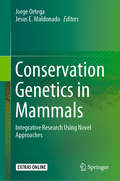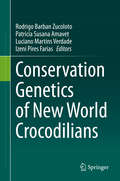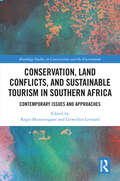- Table View
- List View
Conservation and Utilization of Horticultural Genetic Resources
by P. E. Rajasekharan V. Ramanatha RaoThe conservation of crop genetic resources is one of the important elements in efforts to sustainably increase agricultural production in low-income countries, and to guarantee long-term food security, especially for the low-income population groups in these countries. Horticultural crops, as high-value crops, have an important role to play in revitalizing rural economies and can add significantly to national economies. Moreover, horticulture provides more than twice the number of jobs compared to traditional cereal crop production, and the shifting of conventional agriculture towards high-value horticulture has increased employment opportunities in developing countries. To exploit this potential, researchers need a vast array of horticultural genetic resources and information on new traits. Horticultural crops, which are only a part of PGRFA (Plant Genetic Resources for Food and Agriculture), are characterized by a wide and varied range of species. In fact, there are five major horticultural crop groups: fruit and nut crops, vegetables, food legumes, roots and tubers, and lastly the ornamental and medicinal group. In this context, the present book provides a comprehensive overview of the current state of conservation and utilization of horticultural genetic resources, addressing contemporary approaches to conservation in connection with different technologies, including biotechnological approaches as practised in India and in some cases, globally. It includes a brief chapter on the unique nature of horticultural genetic resources, providing a rationale for viewing them as being distinct from field crop genetic resources. Subsequent chapters share insights on protocols for the conservation of selected horticultural crops ex situ, and focus on the increased need to complement these efforts with in situ conservation approaches. Geospatial tools are also briefly described, emphasizing their utility with regard to mapping and managing resources. The book also explores the wild gene pool in horticulture crops; discusses legal aspects related to horticultural genetic resources and biotechnological aspects; and describes the key aspects of sustainable management and replenishment. Given its scope, the book offers a valuable resource for all horticulturists, graduate students, researchers, policymakers, conservationists, and NGOs engaged in horticulture in particular and biodiversity in general.
Conservation Areas: Conservation Areas Library Ebook (Maps of the Environmental World #4)
by Meg Gillett Jack GillettEach title in the series addresses an environmental topic and illustrated its aspects with the help of maps. An introductory spread presents the topic and explains key ideas, concepts and vocabulary. Twelve spreads each introduce an area of the world, including a map locating relevant sites, graphs offering comparative data and photography.A spread at the back of the book provides further study and comparison exercises.
The Conservation Atlas of Tropical Forests: Asia and the Pacifics
by N. Mark CollinsThe first of a series designed to cover all tropical rain forests in the world. This is a visual portfolio of detailed maps of Asia, accompanied by a text which seeks to analyze the extent and causes of deforestation and to point a way towards sustainable forest development.
The Conservation Atlas of Tropical Forests: Africa
by Jeffrey SayerRecognizing that sound information is vital to the progress of conservation, IUCN have gathered together a visual portfolio of maps of rain forests in Africa. The accompanying text analyzes the extent and causes of deforestation and points a way towards sustainable forest development.
Conservation Behavior: Applying Behavioral Ecology To Wildlife Conservation And Management (PDF) (Conservation Biology Ser. #21)
by Oded Berger-Tal David SaltzConservation behavior assists the investigation of species endangerment associated with managing animals impacted by anthropogenic activities. It employs a theoretical framework that examines the mechanisms, development, function, and phylogeny of behavior variation in order to develop practical tools for preventing biodiversity loss and extinction. Developed from a symposium held at the International Congress on Conservation Biology in 2011, this is the first book to offer an in-depth, logical framework that identifies three vital areas for understanding conservation behavior: anthropogenic threats to wildlife, conservation and management protocols, and indicators of anthropogenic threats. Bridging the gap between behavioral ecology and conservation biology, this volume ascertains key links between the fields, explores the theoretical foundations of these linkages, and connects them to practical wildlife management tools and concise applicable advice. Adopting a clear and structured approach throughout, this book is a vital resource for graduate students, academic researchers, and wildlife managers.
Conservation Biology: Evolution in Action
by Scott P. Carroll Charles W. FoxThe main goal of this book is to encourage and formalize the infusion of evolutionary thinking into mainstream conservation biology. It reviews the evolutionary foundations of conservation issues, and unifies conceptual and empirical advances in evolutionary conservation biology. The book can be used either as a primary textbook or as a supplementary reading in an advanced undergraduate or graduate level course - likely to be called Conservation Biology or in some cases Evolutionary Ecology. The focus of chapters is on current concepts in evolution as they pertain to conservation, and the empirical study of these concepts. The balanced treatment avoids exhaustive reviews and overlapping duplication among the chapters. Little background in genetics is assumed of the reader.
Conservation Biology: Evolution in Action
by Scott P. Carroll Charles W. FoxThe main goal of this book is to encourage and formalize the infusion of evolutionary thinking into mainstream conservation biology. It reviews the evolutionary foundations of conservation issues, and unifies conceptual and empirical advances in evolutionary conservation biology. The book can be used either as a primary textbook or as a supplementary reading in an advanced undergraduate or graduate level course - likely to be called Conservation Biology or in some cases Evolutionary Ecology. The focus of chapters is on current concepts in evolution as they pertain to conservation, and the empirical study of these concepts. The balanced treatment avoids exhaustive reviews and overlapping duplication among the chapters. Little background in genetics is assumed of the reader.
Conservation Biology: The Theory and Practice of Nature Conservation Preservation and Management
by Peggy L. Fiedler• • • John Harper • • • Nature conservation has changed from an idealistic philosophy to a serious technology. Ecology, the science that underpins the technol ogy of conservation, is still too immature to provide all the wisdom that it must. It is arguable that the desire to conserve nature will in itself force the discipline of ecology to identify fundamental prob lems in its scientific goals and methods. In return, ecologists may be able to offer some insights that make conservation more practicable (Harper 1987). The idea that nature (species or communities) is worth preserv ing rests on several fundamental arguments, particularly the argu ment of nostalgia and the argument of human benefit and need. Nostalgia, of course, is a powerful emotion. With some notable ex ceptions, there is usually a feeling of dismay at a change in the sta tus quo, whether it be the loss of a place in the country for walking or rambling, the loss of a painting or architectural monument, or that one will never again have the chance to see a particular species of bird or plant.
Conservation Biology: For the Coming Decade
by Peggy L. Fiedler Peter M. KareivaRefecting what a new generation of conservation biologists is doing and thinking, this vital and far ranging second edition explores where conservation biology is heading. It challenges many conventions of conservation biology by exposing certain weaknesses of widely accepted principles. Combining contributions from both the school and the new breed of conservation biologists, this insightful text focuses primarily on topics the are integral to the daily activities of conservation biologists. Several chapters address ecosystem restoration and biotic invasions as well as the the mechanics of population viability analyses, which are now a routine facet of conservation efforts. A case history approach is implemented throughout the book, with the use of practical real-world examples. Furthermore, an in-depth look at quantitative analyses is presented, allowing for models and mathematical analyses to pinpoint limitations in existing data and guide research toward those aspects of biology that are most likely to be critical to the dynamics of a species or an ecosystem.
Conservation Biology: For the Coming Decade
by Peter M. Kareiva Peggy L. FiedlerReflecting a new generation of conservation biologists' upper-division and graduate level conservation biology courses, as well as for individual reference, this book incorporates a number of new authors and additional chapters, covering all aspects of one of the most dynamic areas in the life sciences. Containing ten additional chapters, it includes such timely topics as ecosystem management and the economics of conservation.
Conservation Biology: Foundations, Concepts, Applications
by Rachel L. Lamb Fred Van DykeThis book provides a thorough, up-to-date examination of conservation biology and the many supporting disciplines that comprise conservation science. In this, the Third Edition of the highly successful Conservation Biology: Foundations, Concepts, Applications, the authors address their interdisciplinary topic as it must now be practiced and perceived in the modern world. Beginning with a concise review of the history of conservation, the authors go on to explore the interplay of conservation with genetics, demography, habitat and landscape, aquatic environments, and ecosystem management, and the relationship of all these disciplines to ethics, economics, law, and policy. An entirely new chapter, The Anthropocene: Conservation in a Human-Dominated Nature, breaks new ground in its exploration of how conservation can be practiced in anthropogenic biomes, novel ecosystems, and urban habitats. The Third Edition includes the popular Points of Engagement discussion questions used in earlier editions, and adds a new feature: Information Boxes, which briefly recap specific case histories described in the text. A concluding chapter offers insight into how to become a conservation professional, in both traditional and non-traditional roles.The authors, Fred Van Dyke and Rachel Lamb, draw on their expertise as field biologists, wildlife managers, consultants to government and industry, and scholars of environmental law, policy, and advocacy, as well as their many years of effective teaching experience. Informed by practical knowledge and acquired skills, the authors have created a work of exceptional clarity and readability which encompasses both systemic foundations as well as contemporary developments in the field. Conservation Biology: Foundations, Concepts, Applications will be of invaluable benefit to undergraduate and graduate students, as well as to working conservation scientists and managers.This is an amazing resource for students, faculty, and practitioners both new and experienced to the field. Diane Debinski, PhD Unexcelled wisdom for living at home on Wonderland Earth, the planet with promise, destined for abundant life. Holmes Rolston, PhDVan Dyke and Lamb have maintained the original text’s emphasis on connecting classical ecological and environmental work with updated modern applications and lucid examples. But more importantly, the third edition contains much new material on the human side of conservation, including expanded treatments of policy, economics, and climate change. Tim Van Deelen, PhD Fred Van Dyke and Rachel Lamb break new ground in both the breadth and depth of their review and analysis of this crucially important and rapidly changing field. Any student or other reader wishing to have a comprehensive overview and understanding of the complexities of conservation biology need look no further – this book is your starting point! Simon N. Stuart, PhD
Conservation Biology in Sub-Saharan Africa
by John W. Wilson Richard B. PrimackConservation Biology in Sub-Saharan Africa comprehensively explores the challenges and potential solutions to key conservation issues in Sub-Saharan Africa. Easy to read, this lucid and accessible textbook includes fifteen chapters that cover a full range of conservation topics, including threats to biodiversity, environmental laws, and protected areas management, as well as related topics such as sustainability, poverty, and human-wildlife conflict. This rich resource also includes a background discussion of what conservation biology is, a wide range of theoretical approaches to the subject, and concrete examples of conservation practice in specific African contexts. Strategies are outlined to protect biodiversity whilst promoting economic development in the region. Boxes covering specific themes written by scientists who live and work throughout the region are included in each chapter, together with recommended readings and suggested discussion topics. Each chapter also includes an extensive bibliography. Conservation Biology in Sub-Saharan Africa provides the most up-to-date study in the field. It is an essential resource, available on-line without charge, for undergraduate and graduate students, as well as a handy guide for professionals working to stop the rapid loss of biodiversity in Sub-Saharan Africa and elsewhere.
Conservation Biology (PDF)
by Andrew S. PullinConservation biology is fast emerging as a major new discipline, which incorporates biological principles in the design of effective strategies for the sustainable management of populations, species and entire ecosystems. This beautifully illustrated textbook introduces students to conservation biology, the science of preserving biodiversity. It begins by taking the reader on a tour of the many and varied ecosystems of our planet, providing a setting in which to explore the factors that have led to the alarming loss of biodiversity that we now see. In particular the fundamental problems of habitat loss and fragmentation, habitat disturbance and the non-sustainable exploitation of species in both aquatic and terrestrial ecosystems are explored. The methods that have been developed to address these problems, from the most traditional forms of conservation, to new approaches at genetic to landscape scales are then discussed, showing how the science can be put into practice.
Conservation Concepts: Rethinking Human–Nature Relationships (Routledge Studies in Conservation and the Environment)
by Kurt JaxThis book provides a review of the multitude of conservation concepts, both from a scientific, philosophical, and social science perspective, asking how we want to shape our relationships with nature as humans, and providing guidance on which conservation approaches can help us to do this. Nature conservation is a contested terrain and there is not only one idea about what constitutes conservation but many different ones, which sometimes are conflicting. Employing a conceptual and historical analysis, this book sorts and interprets the differing conservation concepts, with a special emphasis on narrative analysis as a means for describing human–nature relationships and for linking conservation science to practice and to society at large. Case studies illustrate the philosophical issues and help to analyse major controversies in conservation biology. While the main focus is on Western ideas of conservation, the book also touches upon non-Western, including indigenous, concepts. The approach taken in this book emphasises the often implicit strategic and societal dimensions of conservation concepts, including power relations. In finding a path through the multitude of concepts, the book showcases that it is necessary to maintain the plurality of approaches, in order to successfully address different situations and societal choices. Overall, this book highlights the very tension which conservation biology must withstand between science and society: between what is possible and what we want individually or as a society or even more what is desirable. Bringing some order into this multitude will support more efficient conservation and conservation biology. This book will be of great interest to students and scholars studying nature conservation from a variety of disciplines, including biology, ecology, anthropology, sociology, geography, and philosophy. It will also be of use to professionals wanting to gain an understanding of the broad spectrum of conservation concepts and approaches and when to apply them.
Conservation Concepts: Rethinking Human–Nature Relationships (Routledge Studies in Conservation and the Environment)
by Kurt JaxThis book provides a review of the multitude of conservation concepts, both from a scientific, philosophical, and social science perspective, asking how we want to shape our relationships with nature as humans, and providing guidance on which conservation approaches can help us to do this. Nature conservation is a contested terrain and there is not only one idea about what constitutes conservation but many different ones, which sometimes are conflicting. Employing a conceptual and historical analysis, this book sorts and interprets the differing conservation concepts, with a special emphasis on narrative analysis as a means for describing human–nature relationships and for linking conservation science to practice and to society at large. Case studies illustrate the philosophical issues and help to analyse major controversies in conservation biology. While the main focus is on Western ideas of conservation, the book also touches upon non-Western, including indigenous, concepts. The approach taken in this book emphasises the often implicit strategic and societal dimensions of conservation concepts, including power relations. In finding a path through the multitude of concepts, the book showcases that it is necessary to maintain the plurality of approaches, in order to successfully address different situations and societal choices. Overall, this book highlights the very tension which conservation biology must withstand between science and society: between what is possible and what we want individually or as a society or even more what is desirable. Bringing some order into this multitude will support more efficient conservation and conservation biology. This book will be of great interest to students and scholars studying nature conservation from a variety of disciplines, including biology, ecology, anthropology, sociology, geography, and philosophy. It will also be of use to professionals wanting to gain an understanding of the broad spectrum of conservation concepts and approaches and when to apply them.
Conservation Criminology
by Meredith L. GoreThis important new text introduces conservation criminology as the interdisciplinary study of environmental exploitation and risks at the intersection of human and natural systems. Taking an interdisciplinary approach, the book enhances understanding of the various human and organizational behaviors that pose risks to the environment, humans, and drive conservation crime. As human population growth, global market economies, climate change, deforestation, and illegal exploitation of natural resources continue to increase, academic research from numerous disciplines is needed to address these challenges. Conservation Criminology promotes thinking about how unsustainable natural resources exploitation is a cause and a consequence of social conflict. Case studies profiled in the book demonstrate this cause and effect type situation, as well as innovative approaches for reducing risks to people and the environment. This text encourages readers to consider how humans behave in response to environmental risks and the various mechanisms that constitute effective and ineffective approaches to enforcement of wildlife crimes, including environmental and conservation policy. Case studies from the USA, Latin America, Africa, and Asia highlight corruption in conservation, global trade in electronic waste, illegal fishing, illegal logging, human-wildlife conflict, technology and space, water insecurity, wildlife disease, and wildlife poaching. Taken together, chapters expand the reader’s perspective and employ tools to understand and address environmental crimes and risks, and to provide novel empirical evidence for positive change. With established contributors providing interdisciplinary and global perspectives, this book establishes a foundation for the emerging field of conservation criminology.
Conservation Criminology
by Meredith L. GoreThis important new text introduces conservation criminology as the interdisciplinary study of environmental exploitation and risks at the intersection of human and natural systems. Taking an interdisciplinary approach, the book enhances understanding of the various human and organizational behaviors that pose risks to the environment, humans, and drive conservation crime. As human population growth, global market economies, climate change, deforestation, and illegal exploitation of natural resources continue to increase, academic research from numerous disciplines is needed to address these challenges. Conservation Criminology promotes thinking about how unsustainable natural resources exploitation is a cause and a consequence of social conflict. Case studies profiled in the book demonstrate this cause and effect type situation, as well as innovative approaches for reducing risks to people and the environment. This text encourages readers to consider how humans behave in response to environmental risks and the various mechanisms that constitute effective and ineffective approaches to enforcement of wildlife crimes, including environmental and conservation policy. Case studies from the USA, Latin America, Africa, and Asia highlight corruption in conservation, global trade in electronic waste, illegal fishing, illegal logging, human-wildlife conflict, technology and space, water insecurity, wildlife disease, and wildlife poaching. Taken together, chapters expand the reader’s perspective and employ tools to understand and address environmental crimes and risks, and to provide novel empirical evidence for positive change. With established contributors providing interdisciplinary and global perspectives, this book establishes a foundation for the emerging field of conservation criminology.
Conservation Effectiveness and Concurrent Green Initiatives (Routledge Studies in Conservation and the Environment)
by Li An Conghe Song Qi Zhang Eve BohnettThe book examines concurrent green initiatives and their spillover effects on environmental conservation and management to reveal their impact on conservation effectiveness, drawing on a range of international case studies. Green initiatives are programs, payments, or endeavors that restore, sustain, or improve nature’s capacity, with examples including payments for ecosystem services and the development of nature reserves and protected areas. This book explicitly examines concurrent green initiatives, where initiatives overlap either geographically or in terms of recipients of multiple payments. The book provides a detailed analysis of case studies in the USA and China, including the USA-based Conservation Reserve Program and the Environmental Quality Incentives Program, and the China based Grain-to-Green Program and the Forest Ecological Benefit Compensation Fund. Through this comparison, the book shows the impact of concurrent green initiatives, including additional or unintended benefits for conservation and local communities as well as negative spillover effects. The book complements these case studies by drawing on other global examples ranging in size from local to continental, including planting native trees and shrubs in Australia and green initiatives in the Baltic Sea region. Overall, this book demonstrates the importance of analyzing concurrent green efforts to better understand both the positive and negative impacts to ensure the optimal effectiveness of these policies and programs for conservation and environmental management. This book will be of great interest to students and scholars of environmental conservation and management, land use, ecosystem services and environmental policy, as well as policymakers and practitioners working on environmental initiatives and programs.
Conservation Effectiveness and Concurrent Green Initiatives (Routledge Studies in Conservation and the Environment)
by Li An Conghe Song Qi Zhang Eve BohnettThe book examines concurrent green initiatives and their spillover effects on environmental conservation and management to reveal their impact on conservation effectiveness, drawing on a range of international case studies. Green initiatives are programs, payments, or endeavors that restore, sustain, or improve nature’s capacity, with examples including payments for ecosystem services and the development of nature reserves and protected areas. This book explicitly examines concurrent green initiatives, where initiatives overlap either geographically or in terms of recipients of multiple payments. The book provides a detailed analysis of case studies in the USA and China, including the USA-based Conservation Reserve Program and the Environmental Quality Incentives Program, and the China based Grain-to-Green Program and the Forest Ecological Benefit Compensation Fund. Through this comparison, the book shows the impact of concurrent green initiatives, including additional or unintended benefits for conservation and local communities as well as negative spillover effects. The book complements these case studies by drawing on other global examples ranging in size from local to continental, including planting native trees and shrubs in Australia and green initiatives in the Baltic Sea region. Overall, this book demonstrates the importance of analyzing concurrent green efforts to better understand both the positive and negative impacts to ensure the optimal effectiveness of these policies and programs for conservation and environmental management. This book will be of great interest to students and scholars of environmental conservation and management, land use, ecosystem services and environmental policy, as well as policymakers and practitioners working on environmental initiatives and programs.
Conservation Genetics in Mammals: Integrative Research Using Novel Approaches
by Jorge Ortega Jesus E. MaldonadoThis book focuses on the use of molecular tools to study small populations of rare and endangered mammals, and presents case studies that apply an evolutionary framework to address innovative questions in the emerging field of mammalian conservation genomics using a highly diverse set of novel molecular tools. Novel and more precise molecular technologies now allow experts in the field of mammology to interpret data in a more contextual and empirical fashion and to better describe the evolutionary and ecological processes that are responsible for the patterns they observe. The book also demonstrates how recent advances in genetic/genomic technologies have been applied to assess the impact of environmental/anthropogenic changes on the health of small populations of mammals. It examines a range of issues in the field of mammalian conservation genomics, such as the role that the genetic diversity of the immune system plays in disease protection and local adaptation; the use of noninvasive techniques and genomic banks as a resource for monitoring and restoring populations; the structuring of population by physical barriers; and genetic diversity. Further, by integrating research from a variety of areas – including population genetics, molecular ecology, systematics, and evolutionary and conservation biology – it enables readers to gain a deeper understanding of the conservation biology of mammals that are at increasing risk of extinction at local, regional and global scales. As such, it offers a unique resource for a broad readership interested in the conservation biology of mammals and conservation management strategies to better preserve biodiversity.
Conservation Genetics in the Neotropics
by Pedro M. GalettiThis book explores how genetics and the new technologies in genomics have been used for conservation of plants and animals in the Neotropics. It shows the new perspective for conservation genetics beyond the use of theoretical and methods in genetics at species level and presents how genetics and genomics can be used for assessing communities. Conservation genetics and genomics are presented as a helpful field of study for resolving taxonomic uncertainties and hidden biodiversity, understanding populations and extinction risk, genetic management, wildlife forensic genetics, assessing biology and molecular ecology, assessing communities, conservation genomics and the use of conservation biology and genetics in science learning, highlighting case studies in the Neotropics. Applications of conservation genetics for management or policy, decision making, planning, and implementation of conservation practice in the Neotropics are addressed across chapters. This book will interest to researchers and students in conservation genetics and biology conservation interested in the Neotropics. Stakeholders and decision makers in conservation biology may also find this book useful.
Conservation Genetics of New World Crocodilians
by Rodrigo Barban Zucoloto Patricia Susana Amavet Luciano Martins Verdade Izeni Pires FariasThis book aims to be a comprehensive review of the literature on the conservation genetics of the New World crocodilians, from the biological and demographical aspects of the living species to the application of molecular techniques for conservation purposes. It covers the current status of the molecular genetics applied to phylogenetics, phylogeography, diversity, kinship and mating system, and hybridization, as well its implications for decision making with regards to the conservation of these species at academic and governmental levels. This book can be used as a guide for graduate and undergraduate students to understand how conservation genetics techniques are carried out and how they can help preserve not only crocodilians but also other living species.
Conservation in Chilean Patagonia: Assessing the State of Knowledge, Opportunities, and Challenges (Integrated Science #19)
by Juan Carlos Castilla Juan J. Armesto María José Martínez-Harms David TecklinChilean Patagonia, located at the southwestern tip of South America, is one of the last regions on earth where highly intact environments predominate. With a coastline that extends along some 100,000 km of fjords, channels, and islands, it has one of the world´s most extensive marine-terrestrial interfaces. Local place-based and Indigenous cultures and management practices are a vital presence across the region, while the long and rich history of conservation efforts have resulted in officially protected areas covering over 50% of the land and 41% of the coastal-marine area. However, Chilean Patagonia is increasingly facing anthropogenic pressures associated with increased infrastructure and access, salmon aquaculture, extractive industries, and the spread of invasive exotic species. Despite widespread recognition that Chilean Patagonia represents a unique global reservoir of socio-natural heritage, to date there has been no region-wide assessment of the scientific evidence of the conservation status of its ecosystems or the priorities for their effective conservation.Conservation in Chilean Patagonia: Assessing the state of knowledge, opportunities, and challenges is the first book to gather and synthesize the available scientific and socio-environmental information related to Patagonian conservation. It presents the collaborative work of 68 researchers and local experts, representing a range of specialties and perspectives, including: biology, ecology, socio-ecology, fisheries, aquaculture, anthropology, economics, geography, tourism, cryosphere, oceanography, climate and global change. The book’s 18 chapters focus on the status of key ecosystems and conservation tools, and provide recommendations toward the construction of a renewed, inclusive, and integrated conservation agenda for the Chilean Patagonian region. It provides an essential primer for anyone interested in the future of this ecologically vital region, as well as lessons on interdisciplinary collaboration and integrated analysis of conservation issues useful for conservation practitioners and scholars. This is an open access book.This book is a translation of an original Spanish edition. The translation was done with the help of artificial intelligence (machine translation by the service DeepL.com). A subsequent human revision was done primarily in terms of content, so that the book will read stylistically differently from a conventional translation.
Conservation, Land Conflicts and Sustainable Tourism in Southern Africa: Contemporary Issues and Approaches (Routledge Studies in Conservation and the Environment)
by Regis Musavengane Llewellyn LeonardThis book examines the nexus between conservation, land conflicts and sustainable tourism approaches in Southern Africa, with a focus on equity, access, restitution and redistribution. While Southern Africa is home to important biodiversity, pristine woodlands and grasslands, and is a habitat for important wildlife species, it is also a land of contestations over its natural resources with a complex historical legacy and a wide variety of competing and conflicting issues surrounding race, cultural and traditional practices and neoliberalism. Drawing on insights from conservation, environmental and tourism experts, this volume presents the nexus between land conflicts and conservation in the region. The chapters reveal the hegemony of humans on land and associated resources including wildlife and minerals. By using social science approaches, the book unites environmental, scientific, social and political issues as it is imperative we understand the holistic nature of land conflicts in nature-based tourism. Discussing the management theories and approaches to community-based tourism in communities where there is or were land conflicts is critical to understanding the current state and future of tourism in African rural spaces. This volume determines the extent to which land reform impacts community-based tourism in Africa to develop resilient destination strategies and shares solutions to existing land conflicts to promote conservation and nature-based tourism. The book will be of great interest to students, academics, development experts, and policymakers in the field of conservation, tourism geography, sociology, development studies, land use and environmental management and African studies.
Conservation, Land Conflicts and Sustainable Tourism in Southern Africa: Contemporary Issues and Approaches (Routledge Studies in Conservation and the Environment)
by Regis Musavengane and Llewellyn LeonardThis book examines the nexus between conservation, land conflicts and sustainable tourism approaches in Southern Africa, with a focus on equity, access, restitution and redistribution. While Southern Africa is home to important biodiversity, pristine woodlands and grasslands, and is a habitat for important wildlife species, it is also a land of contestations over its natural resources with a complex historical legacy and a wide variety of competing and conflicting issues surrounding race, cultural and traditional practices and neoliberalism. Drawing on insights from conservation, environmental and tourism experts, this volume presents the nexus between land conflicts and conservation in the region. The chapters reveal the hegemony of humans on land and associated resources including wildlife and minerals. By using social science approaches, the book unites environmental, scientific, social and political issues as it is imperative we understand the holistic nature of land conflicts in nature-based tourism. Discussing the management theories and approaches to community-based tourism in communities where there is or were land conflicts is critical to understanding the current state and future of tourism in African rural spaces. This volume determines the extent to which land reform impacts community-based tourism in Africa to develop resilient destination strategies and shares solutions to existing land conflicts to promote conservation and nature-based tourism. The book will be of great interest to students, academics, development experts, and policymakers in the field of conservation, tourism geography, sociology, development studies, land use and environmental management and African studies.

